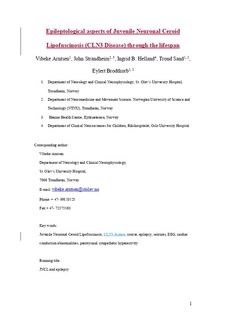| dc.contributor.author | Arntsen, Vibeke | |
| dc.contributor.author | Strandheim, John | |
| dc.contributor.author | Helland, Ingrid B | |
| dc.contributor.author | Sand, Trond | |
| dc.contributor.author | Brodtkorb, Eylert | |
| dc.date.accessioned | 2020-03-16T08:35:05Z | |
| dc.date.available | 2020-03-16T08:35:05Z | |
| dc.date.created | 2019-06-11T16:27:33Z | |
| dc.date.issued | 2019 | |
| dc.identifier.citation | Epilepsy & Behavior. 2019, 94 59-64. | nb_NO |
| dc.identifier.issn | 1525-5050 | |
| dc.identifier.uri | http://hdl.handle.net/11250/2646863 | |
| dc.description.abstract | Purpose
Juvenile neuronal ceroid lipofuscinosis (CLN3 disease) is the most common neurodegenerative disorder in childhood with survival until young adult age. Visual loss is followed by epilepsy, cognitive, neuropsychiatric, and motor symptoms. We have studied the evolution of electroencephalographic (EEG) and seizure characteristics.
Methods
Twenty-four patients were recruited via the Norwegian CLN3 disease parent association. Parents were interviewed. Medical records and EEG reports/recordings were collected. Electroencephalographic elements were classified according to Standardized computer-based organized reporting of EEG (SCORE). The evolution of EEG features along with seizure types was assessed by testing the difference in proportions with standardized normal deviate comparing findings below and above 15 years of age.
Results
Mean age at study or death (n = 12) was 21.2 (10–39) years. Twenty-two patients had experienced seizures; the first was usually bilateral tonic–clonic (TC). Later, focal motor seizures frequently occurred, often with increasing multifocal and polymorphic features. Paroxysmal nonepileptic motor and autonomous symptoms were also suspected in several patients. Distinct myoclonic seizures were uncommon. In four patients, we identified episodes of bradycardia/sinus arrest. Electroencephalography showed progressive slowing of the background activity (p = 0.029). Focal epileptiform discharges were rare and mainly seen at age < 10. Combined multifocal and bilateral epileptiform discharges increased in adolescence (p = 0.002).
Conclusion
Seizure and EEG characteristics change with time in CLN3 disease. Tonic–clonic seizures are common at onset, and multifocal motor seizures increase with age. In contrast, focal epileptiform abnormalities are more common in childhood, compared to later multifocal and bilateral discharges. This seizure disorder belongs to the combined generalized and focal epilepsies. Paucity of myoclonic seizures does not warrant classification as a classic progressive myoclonic epilepsy. When attacks with only behavior arrest occur, cardiac conduction abnormalities should be considered. | nb_NO |
| dc.language.iso | eng | nb_NO |
| dc.publisher | Elsevier | nb_NO |
| dc.rights | Attribution-NonCommercial-NoDerivatives 4.0 Internasjonal | * |
| dc.rights.uri | http://creativecommons.org/licenses/by-nc-nd/4.0/deed.no | * |
| dc.title | Epileptological aspects of juvenile neuronal ceroid lipofuscinosis (CLN3 disease) through the lifespan | nb_NO |
| dc.type | Journal article | nb_NO |
| dc.type | Peer reviewed | nb_NO |
| dc.description.version | acceptedVersion | nb_NO |
| dc.source.pagenumber | 59-64 | nb_NO |
| dc.source.volume | 94 | nb_NO |
| dc.source.journal | Epilepsy & Behavior | nb_NO |
| dc.identifier.doi | 10.1016/j.yebeh.2019.02.020 | |
| dc.identifier.cristin | 1704134 | |
| dc.description.localcode | © 2019. This is the authors’ accepted and refereed manuscript to the article. This manuscript version is made available under the CC-BY-NC-ND 4.0 license http://creativecommons.org/licenses/by-nc-nd/4.0/ | nb_NO |
| cristin.unitcode | 1920,16,0,0 | |
| cristin.unitcode | 194,65,30,0 | |
| cristin.unitname | Nevroklinikken | |
| cristin.unitname | Institutt for nevromedisin og bevegelsesvitenskap | |
| cristin.ispublished | true | |
| cristin.fulltext | postprint | |
| cristin.qualitycode | 1 | |

